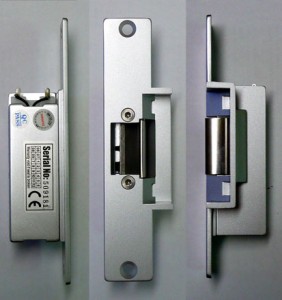An electric strike is an access control device used for doors. It replaces the fixed strike faceplate often used with a latchbar (also known as a keeper).
Like a fixed strike, it normally presents a ramped surface to the locking latch allowing the door to close and latch just like a fixed strike would. However, an electric strike’s ramped surface can, upon command, pivot out of the way of the latch allowing the door to be pushed open (from the outside) without the latch being retracted (that is, without any operation of the knob) or while excited the knob or lever can be turned to allow egress from the secured area.
Electric strikes are generally available in two configurations:
- Fail-secure: Also called fail-locked or non-fail safe. In this configuration, applying electric current to the strike will cause it to open. In this configuration, the strike would remain locked in a power failure, but typically the knob can still be used to open the door from the inside for egress from the secure side. These units can be powered by alternating current, which will cause the unit to buzz, or DC power, which offers silent operation, except for a “click” while the unit releases.
- Fail-safe: Also called fail-open. In this configuration, applying electric current to the strike will cause it to lock. It operates the same as amagnetic lock would. If there is a power failure, the door opens merely by being pushed or pulled. Fail-safe units are always operated with direct current.
|
 Electric strikes are generally available in two configurations: Fail-secure and fail-safe. |
